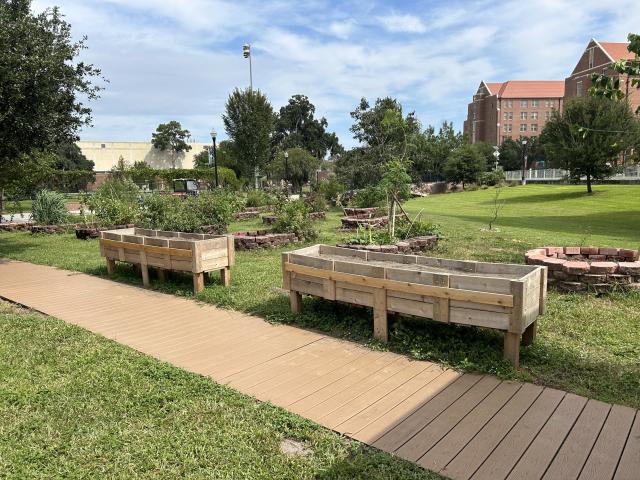Accessible Gardening

Gardening is a well-loved hobby for many, and has been shown to have positive benefits for gardeners’ physical and mental health. There are ways to make this leisurely activity accessible for everyone, regardless of age, physical ability, or limitations. Within the Seminole Organic Garden, Sustainable Campus has been working on creating an accessible space for the FSU community, and we want to share some of the advancements we’ve made.
What Is An Accessible Garden?
There are many aspects of gardening that may be inaccessible or unnecessarily difficult for those with mobility issues or sensory issues. Some of these limitations include traveling on uneven soil, crouching and bending to care for plants, and the fine motor control and grip strength required for some gardening tools. An accessible garden is simply a garden space that reduces those difficulties and makes the space usable to as many people as possible. Depending on who the targeted users of the garden are–accessibility in a small home garden is going to look very different from accessibility for a large-scale community garden!
At the Seminole Organic Garden, we’ve installed raised garden beds to allow ease of access, ensured our walkways are accessible by a variety of mobility aids, created accessible shaded areas to provide rest from being in the sun and heat, and helped make watering easier for all gardeners.
How Gardening Can Be Made Accessible - The Seminole Organic Garden
Raised Beds
One of the most common adjustments to see to make gardens more accessible are raised planters and beds. This can alleviate the stress from having to kneel, bend, or crouch, which can be harsh on the joints for anyone with mobility issues. It also allows beds to be more easily used by gardeners in wheelchairs, who can pull up alongside beds and care for their garden plot using a sideways approach. The Seminole Organic Garden recently installed two ADA-compliant accessible garden beds. These beds are within standards to be easily usable by wheelchair users to sit alongside them and comfortably garden.
Accessible Walkways
To open the garden to as many people as possible, the garden was constructed with accessibility and growth in mind, intending to grow more inclusive over time. In the initial construction it was ensured that all walkway materials were approved as safe for wheelchair and walker use. Any transitions between different surface types, such as from the main campus sidewalk to the walkway to the gazebo are all flush with each other to reduce risk of tripping hazards. Finally, all walkways are 5 feet wide to allow space for both a wheelchair and a pedestrian to use at the same time, and to allow turning space for wheelchair users. Making the garden accessible at this foundational level was the first step towards building a truly inclusive space.
Plenty of Shade
Outdoor gardening can be an arduous task, especially as the weather gets warmer. As both a safety and comfort precaution, accessible gardens should have plenty of spaces to rest in the shade. Sun sickness and heat exhaustion are significant threats when spending hours in the sun. Areas to rest comfortably are also important to avoid overexertion, which can have serious negative health effects on its own. To combat this issue, the Seminole Organic Garden features a gazebo with open space in the center and benches along the edges. This space helps to alleviate heat exhaustion risks and is accessible for wheelchair users.
Ease of Watering
Similar to maintenance of plants through planting, pruning, and harvesting, watering can be a physically challenging task. In addition to the need for bending and fine motor control, filling and carrying potentially heavy containers of water from the water source to their garden plot can be challenging for some gardeners. Currently, watering at the Seminole Organic Garden is carried out by the Garden Coordinator to alleviate the burden of watering from renters entirely.
The Bigger Picture
Why does it matter? Taking actions to make gardening more sustainable can help support the global Sustainable Development Goals (SDGs) on an individual level. Creating accessible gardens opens up opportunities for individuals who may have been blocked from conventional gardening, supporting SDG 10: Reduced Inequalities. Gardening also allows more individuals to spend time exerting physical energy outdoors, improving mental and physical wellbeing (SDG 3: Good Health and Well-Being). Gardening can also be a renewable source of food, as many gardeners opt to grow fruit or vegetables in their garden plots (SDG 2: Zero Hunger and SDG 12: Responsible Consumption and Production). Gardening is a beloved hobby for many, praised as being relaxing, rewarding, and rejuvenating. In the best interest of our communities there are steps we can take to make it possible for everyone.
Want to stay up to date with Sustainable Campus? Follow us on Instagram at @fsusustainable for information on sustainability at Florida State University and beyond.
Sources
Ten Ways To Make Your Home Garden More Accessible. (2020, March 13). Craig. https://craighospital.org/blog/ten-ways-to-make-your-home-garden-more-accessible
Making Gardens Accessible For All. (2022). In P-Patch Community Gardening. Seattle Department of Neighborhoods. https://www.seattle.gov/documents/Departments/Neighborhoods/PPatch/Tips/307_Accessible_Gardens.pdf
Accessible Gardens - Gardening Solutions - University of Florida, Institute of Food and Agricultural Sciences. (n.d.). University of Florida Gardening Solutions. https://gardeningsolutions.ifas.ufl.edu/design/types-of-gardens/accessible-gardens.html#:~:text=Ramps%20with%20railings%20also%20make,canopies%20to%20create%20rest%20areas
Accessible Gardening : NCHPAD - Building Inclusive Communities. (n.d.). National Center on Health, Physical Activity and Disability (NCHPAD). https://www.nchpad.org/1496/6449/Accessible~Gardening
Bawden-Davis, J. (n.d.). How To Create A More Accessible Garden. GardenTech. https://www.gardentech.com/blog/gardening-and-healthy-living/gardening-for-everyone-creating-accessible-garden
